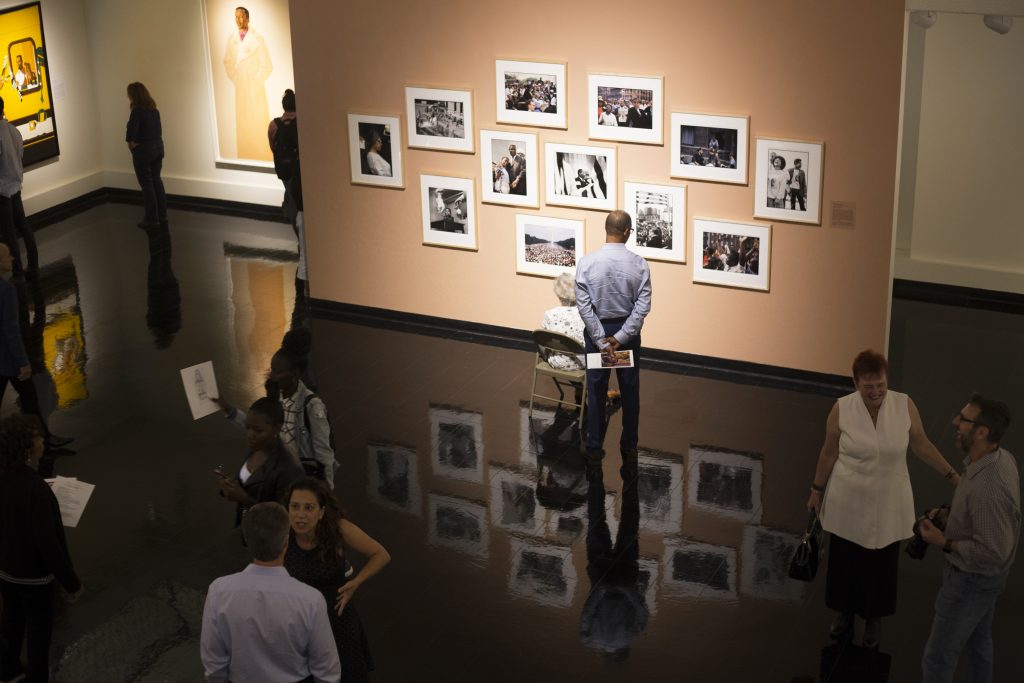This week, the Binghamton University Art Museum presented depictions of the difficulties of finding self-identity as a marginalized person with its newest gallery exhibition. The gallery, “not but nothing other: African-American Portrayals, 1930s to Today” opened on Thursday.
Titled after Fred Moten’s poem of the same name, the gallery’s pieces portrayed the long-winded African American struggle for the right to identity. The central piece of the exhibit, a collection of shiny cymbals arranged low to the ground in the center of the museum floor, will immediately catch the eyes and ears of museum-goers.
“This piece is 37 cymbals arranged in a shell-like formation that goes off every 7 to 12 minutes, and it was designed by deceased artist Terry Adkins,” said Dr. Claire Kovacs, curator of the Binghamton Art Museum. “It was made after a character named Bigger Thomas in the play ‘Native Son,’ who struggled with white America recognizing his humanity, and the cymbals symbolize one making their presence felt.”
On opening night, the exhibition displayed artwork from prominent artists such as Glenn Ligon and Emma Amos, but also included a poetry reading from local Binghamton resident Brenda Cave-James. Cave-James is also the co-founder of “Trav’lin This Road,” a performance ensemble dedicated to preserving the past and present of the black American experience.
“Brenda was asked to make a poem in response to this exhibition, and there’s sort of a tradition of this type of poetry where it’s in dialogue with works of art,” said Kovacs. “I really think folks responded well to it, along with the Adkins piece it provided another layer of liveliness to the space.”
The event served as the most extensive display of African-American artwork in the history of the BU Art Museum and drew a diverse group of attendees, according to Kovacs.
“I have never been to an opening here before because I’m new but I would say that it felt like a decent demographic mix of both students, faculty and staff and community members,” Kovacs said. “Keeping that balance is something we really want to keep going forward.”
Upon entering the museum, attendees were greeted by a pamphlet introducing the pieces of artwork, a schedule of upcoming BU Art Museum events and a QR code that provided a digital guide for the exhibition. The guide walks guests through the various pieces in the gallery beginning with Ligon’s “Runaways, 1993.” Inspired by advertisements for escaped slaves, Ligon asked 10 of his friends to describe him and printed them onto lithographs for a runaway slave named Glenn.
The artwork addressed a number of topics ranging from the Harlem Renaissance to reimaginings of historical figures, such as Harriet Tubman. A piece titled “Harriet, 1975” by Elizabeth Catlett displayed Tubman in a particularly empowering light. The portrait displays Tubman holding a rifle in one hand as she points freed slaves onward with her other hand.
Maeve Connolly, a junior majoring in integrative neuroscience, said the image reflects Tubman’s importance.
“I like that Harriet Tubman painting a lot — she looks larger than life,” said Connolly. “Bigger than everyone else in the frame, I don’t think there’s any better way to depict such an important figure.”
Although this is her first month as curator of the Art Museum, Kovacs said that meshing the student community with the larger Binghamton community through art is one of her goals.
“One of the things I’ve been brought on to do is to think about deeper engagement with students, so BU students thinking about the museum, the exhibition and everything else as places where they see themselves, ” said Kovacs. “Also, doing that in a way that connects the students to the community because I think that the arts can be a gateway between the students and the community.”
The exhibition will remain open until Dec. 7. Additionally, on Sept. 25 at 6 p.m., Binghamton alumnus and celebrated actor, writer and director Reuben Santiago-Hudson will come to the Art Museum to discuss African-American portrayals in art and popular culture.



